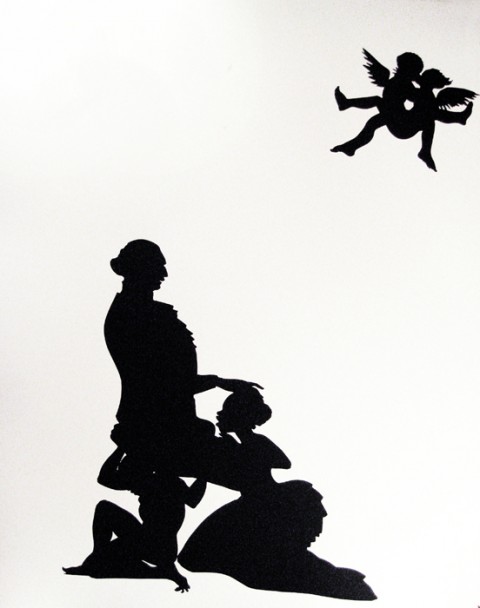
The Atlantic Slave Trade, in Silhouette
Antebellum plantation life is something that all-too-often white America rehashes in a myriad of ways from subdivisions bulldozed into the hillsides of southern states with names like ‘Saint James Plantation’ to naming Gone with the Wind on lists of ‘best novels’ without a hint of irony, analysis, or even an (unacceptable) apologetic cringe. This rehashing reiterates the racism used to justify slavery in America and brings it very much into the present with, often, a complete lack of awareness. Artist Kara Walker faces head-on these issues, and more, when she addresses the representation of race, racism, and slavery with her unflinching paper-cut silhouettes displaying the violence of the Atlantic slave trade and the harrowing reality of sexual violence, commodification of human lives, and racial stereotypes. She says herself, “Most pieces have to do with exchanges of power, attempts to steal power away from others.” Her work is powerful and welcome in a world that too often tries to sugar coat, dismiss, or otherwise contend that we should all ‘move on’.
Kara Walker and her Art
Kara Walker was born in 1969 in Stockton, California and moved to Georgia at 13. She studied art at Atlanta College of Art and Rhode Island School of Design receiving her BA and BFA, respectively, in 1991 and 1994. Her work has shown internationally at the Museum of Contemporary Art, Chicago; the Museum of Modern Art, New York; the Museum voor Modern Kunst (The Netherlands); and the Solomon R. Guggenheim Museum, New York. Among many, many others that you can see on her exhibition page. She’s well-known for her work in silhouette, but keep in mind that she also works in painting and media.
But for this post, though, I’ll be looking specifically at her work in silhouette. Which is killer powerful. Using the medium of the paper cut silhouette Walker alludes to the 18th century bourgeois elite that popularized the art form and, in doing so, creates a collision of juxtaposed ideas: rather than the paper-cut silhouette telling the story of privilege it tells the story of what the elite, or the oppressor, did throughout slavery. The pastoral placidity of silhouettes exist in stark contrast to the images that regale the viewer with vicious, disruptive images of slavery, violence, and racist stereotypes. It’s a reflection of the dynamic that exists in America on the topic of slavery: the placid pretending of an issue that has past with the trauma of the truth – both past and present. You can listen to her discuss paper-cut silhouette and the meaning it has for her.
Sexual Violence and the Slave Trade
Sexual violence is a recurring theme in Walker’s work. In the image below, we see a white slave owner seated, literally, on the shoulders of a young enslaved boy, which positions the owner to receive oral sex from a young enslaved woman kneeling in front of him. The young boy calls to mind the condemned Atlas, destined forever to carry the weight of (depending on which version you prefer) the sky, Earth, or Uranus. The young woman, hesitant in her body language, is forced into her prone position by the guiding hand of the man who owns her (or might, given the widespread sexual violation of enslaved women by the men who enslaved them). His hand hovers delicately above her head, as if he were penning a letter to his sister, or about to pick up a cup of tea. But this wolf cloaked in sheep’s clothing, as-it-were, is exactly the point. The silhouette of the white owner brings to mind images of founding fathers with their neatly powdered wigs, ruffled shirts, and high collars. This comparison, given that so many of the founding fathers owned slaves (including George Washington and Thomas Jefferson), asks the viewers to consider who slave owners actually were that were capable of such loathsome behavior. It could be easy to dismiss a slave owner who raped his slave as a violent monster and the exception. But what if he were a well-respected community leader? Or the President of the United States? Viewers must reconsider the inhumanity of slavery, and who the perpetrators were, and whether this vicious sexual violence and oppression was actually the norm as opposed to the exception. With deft snips of her scissors, Walker captures the exploitation of enslaved people who were commodified in order to support an economic system that lived and breathed cotton. As Kara Walker says herself, “My works are erotically explicit, shameless. I would be happy if visitors would stand in front of my work and feel a bit ashamed—ashamed because they have…simply believed in the project of modernism.”

Likewise, we see sexual violence again in the below image, this time between a white boy and enslaved black girl. The innocent image of two children playing in a field on a sunny day turns on its head as the girl, crouched on her knees, performs oral sex on the boy who seems entirely absorbed in his playful day and unaware of the trauma his role in race and racism creates. It’s disturbing at the very least and, again, that’s the point. When white America romanticizes antebellum plantations they might think of Scarlett O’Hara, sweet Southern accents, and buoyant gowns. But they might do better to also be thinking of this:
Truth about the Slave Trade: Then and Now
Walker’s work asks viewers to consider what’s really happening in a piece. Is it real? What is the line between imagination and fantasy? And have fantasies allowed for the exploitation of human lives throughout slavery and to the present day? Are the feelings happening inside the viewer occurring because of Walker’s work or because of a complicated interplay between her work and the individual viewer’s unique perceptions of race, racism, and the history of slavery in America? Walker invites the viewer to consider the true story of slavery as opposed to the story that is told in American classrooms – glossed over and put aside. Her work is provocative, upsetting, disturbing, and powerful.
Walker successfully takes the viewer on a journey into the truths of slavery and racism and how the viewer has been complicit. She doesn’t instruct the viewer but instead allows us to sit with our own discomfort. She says herself:
“I don’t know how much I believe in redemptive stories, even though people want them and strive for them. They’re satisfied with stories of triumph over evil, but then triumph is a dead end. Triumph never sits still. Life goes on. People forget and make mistakes. Heroes are not completely pure, and villains aren’t purely evil. I’m interested in the continuity of conflict, the creation of racist narratives, or nationalist narratives, or whatever narratives people use to construct a group identity and to keep themselves whole—such activity has a darker side to it, since it allows people to lash out at whoever’s not in the group. That’s a contact thread that flummoxes me.”
Walker does not shy away from the trauma of the Atlantic slave trade, the realities of slavery, or the pervasive racist stereotype. She forces the viewer to confront these painful realities and racism (even if internalized) and to consider what role we have played in ignoring, romanticizing, supporting, or silencing by allowing us to sit with our own discomfort without assurances or exit. It’s not a comfortable experience, looking at her work. But somehow it’s a relief (in the way that honesty can be an uncomfortable relief) to see the train wreck of truth and lies that pervade this country splashed, literally, across a wall. Her work is a welcome antithesis of cheery book-list recommendations suggesting Gone with the Wind as one of the 50 best novels and the pandemic of newly-bulldozed subdivisions bearing the word, somewhere in their name, ‘Plantation’.
And you can see her work soon, too. Check out her upcoming exhibit in Brooklyn this May. It’s showing in a Domino Sugar warehouse, no less. Like I said, she doesn’t mince words. Or silhouettes.
images via Ozarts etc
